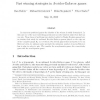129
click to vote
CPC
2011
14 years 7 months ago
2011
Consider a randomly oriented graph G = (V, E) and let a, s and b be three distinct vertices in V . We study the correlation between the events {a → s} and {s → b}. We show that...
COMBINATORICS
2000
15 years 6 days ago
2000
A counterexample is presented to Gy. Elekes's conjecture concerning the existence of long 2-colored paths in properly colored graphs. A modified version of the conjecture is ...
77
Voted
JCT
2007
15 years 8 days ago
2007
In numerous positional games the identity of the winner is easily determined. In this case one of the more interesting questions is not who wins but rather how fast can one win. T...
87
Voted
CPC
2008
15 years 13 days ago
2008
A Graph Construction Game is a Maker-Breaker game. Maker and Breaker take turns in choosing previously unoccupied edges of the complete graph KN . Maker's aim is to claim a c...
110
Voted
ARSCOM
2007
15 years 15 days ago
2007
We partition the set of spanning trees contained in the complete graph Kn into spanning trees contained in the complete bipartite graph Ks,t. This relation will show that any prop...
88
Voted
GD
2004
Springer
15 years 5 months ago
2004
Springer
The no-three-in-line problem, introduced by Dudeney in 1917, asks for the maximum number of points in the n × n grid with no three points collinear. In 1951, Erd¨os proved that t...


